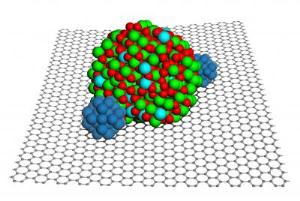 |
A nanoparticle of indium tin oxide (green and red) braces platinum nanoparticles (blue) on the surface of graphene (black honeycomb) to make a hardier, more chemically active fuel cell material.
[Credit: Mike Perkins/PNNL] |
"This material has great potential to make fuel cells cheaper and last longer," said catalytic chemist Yong Wang, who has a joint appointment with PNNL and WSU. "The work may also provide lessons for improving the performance of other carbon-based catalysts for a broad range of industrial applications."
Muscle Metal Oxide
Fuel cells work by chemically breaking down oxygen and hydrogen gases to create an electrical current, producing water and heat in the process. The centerpiece of the fuel cell is the chemical catalyst - usually a metal such as platinum - sitting on a support that is often made of carbon. A good supporting material spreads the platinum evenly over its surface to maximize the surface area with which it can attack gas molecules. It is also electrically conductive.
Fuel cell developers most commonly use black carbon - think pencil lead - but platinum atoms tend to clump on such carbon. In addition, water can degrade the carbon away. Another support option is metal oxides - think rust - but what metal oxides make up for in stability and catalyst dispersion, they lose in conductivity and ease of synthesis. Other researchers have begun to explore metal oxides in conjunction with carbon materials to get the best of both worlds.
As a carbon support, Liu and his colleagues thought graphene intriguing. The honeycomb lattice of graphene is porous, electrically conductive and affords a lot of room for platinum atoms to work. First, the team crystallized nanoparticles of the metal oxide known as indium tin oxide - or ITO - directly onto specially treated graphene. Then they added platinum nanoparticles to the graphene-ITO and tested the materials.
Platinumweight
The team viewed the materials under high-resolution microscopes at EMSL, DOE's Environmental Molecular Sciences Laboratory on the PNNL campus. The images showed that without ITO, platinum atoms clumped up on the graphene surface. But with ITO, the platinum spread out nicely. Those images also showed catalytic platinum wedged between the nanoparticles and the graphene surface, with the nanoparticles partially sitting on the platinum like a paperweight.
To see how stable this arrangement was, the team performed theoretical calculations of molecular interactions between the graphene, platinum and ITO. This number-crunching on EMSL's Chinook supercomputer showed that the threesome was more stable than the metal oxide alone on graphene or the catalyst alone on graphene.
But stability makes no difference if the catalyst doesn't work. In tests for how well the materials break down oxygen as they would in a fuel cell, the triple-threat packed about 40% more of a wallop than the catalyst alone on graphene or the catalyst alone on other carbon-based supports such as activated carbon.
Last, the team tested how well the new material stands up to repeated usage by artificially aging it. After aging, the tripartite material proved to be three times as durable as the lone catalyst on graphene and twice as durable as on commonly used activated carbon. Corrosion tests revealed that the triple threat was more resistant than the other materials tested as well.
The team is now incorporating the platinum-ITO-graphene material into experimental fuel cells to determine how well it works under real world conditions and how long it lasts.
This work was supported by the U.S. Department of Energy Office of Energy Efficiency and Renewable Energy.



